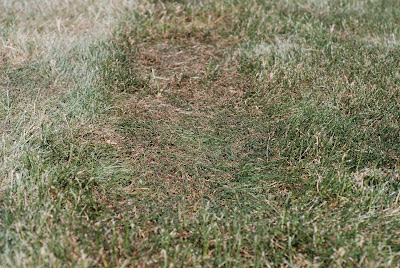Time to Water?
With the heat and dry conditions most in Indiana are experiencing, many turf areas are starting to brown. Water is critical to the growth of all plants, not just turfgrass. Turfgrass leaves and shoots are comprised of about 80% water. A lack or water (rainfall or irrigation) will lead to a decrease in growth and energy production and an increase in plant stress. When turf has insufficient water it will begin to wilt. Leaves will roll or fold to conserve water by reducing their leaf area. The easiest way to determine whether or not turf is wilting is to walk across it. If you notice that your footprints don't bounce back right away, this is a sign the plant is drought stressed. Following these initial symptoms, plants will turf from a green wilted appearance to brown in colors as the leaves die (not the plant) and the turf enters a drought induced dormancy.
 |
Foot-printing is the first sign of moisture stress and can be
spotted when the turf does not “bounce-back” after walking across it due to
moisture stress and a lack of water.
|
 |
| Damage from mower traffic on drought stressed turf. |
 |
Notice how the turf is laid down here after the tires from the mower
ran across it and the turf has not “bounced-back” due to moisture stress and a
lack of water.
|
How should turf be managed during dry spells and drought?
When possible stay off the turf! Limit traffic (including mowing) to minimize crushing of the turfgrass leaves and crowns and causing damage. In order to keep your lawn green during hot and dry periods at least 1.0 inch of water will need to be applied weekly. However, with far less water you can keep your lawn alive. Water once every 2-4 weeks with ½ inch of water to keep turf plant crowns hydrated during drought. This amount of water will not green up the turf, but it will increase its long-term survival during long dry spells.
When irrigating it is best to irrigate early in the morning, but occasional watering at mid-day or early in the morning in order to prevent injury from moisture stress is allowable. Following wilt, turf should recover very quickly within a few hours. However, following drought (brown turf), turf will require at least 1-2 weeks after significant rainfall returns to recover.
Aaron Patton, Turfgrass Extension Specialist





1 comments:
Thanks for sharing this article, its been a really fun read. I've never dealt with turf in vancouver before. I've heard its easy to work with, I guess we'll see soon enough.
May 22, 2013 at 5:31 PMPost a Comment
Note: Only a member of this blog may post a comment.